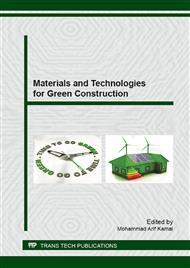[1]
D.B. Shaw, C.E. Weaver. The mineralogical composition of shales. J. Sed. Pet. 35, 213-222, (1965).
Google Scholar
[2]
R.E. Grim, Applied Clay Mineralogy. McGraw-Hill, New York, p.422, (1962).
Google Scholar
[3]
S. Guggenheim, R. T. Martin, Reply to the comment by D.M. Moore on: Definition of clay and clay mineral: Joint Report of the AIPEA Nomenclature and CMS Nomenclature Committees. Clay and Clay Minerals, Vol. 44 (5), pp.713-715, (1966).
DOI: 10.1346/ccmn.1996.0440516
Google Scholar
[4]
D.M. Moore, R.C. Jr. Reynolds 1997, X-Ray Diffraction and the Identification and Analysis of Clay Minerals, 2nd Edition. Oxford University Press, Oxford and New York, p.378, (1997).
Google Scholar
[5]
G. M Reeves, I. Sims, J. C Cripps, Clay Materials Used in Construction, Geological Society, London, Engineering Geology Special Publication 21, (2006).
Google Scholar
[6]
C. K Wentworth, A scale of grade and class terms for clastic sediments. Journal of Geology, Vol. 30, p.377–392, (1922).
DOI: 10.1086/622910
Google Scholar
[7]
R. E Grim, Clay Mineralogy, 2nd Edition. McGraw-Hill, New York, p.596, (1968).
Google Scholar
[8]
G. Minke, Building with earth. Design and Technology of a Sustainable Architecture. Birkhauser, (2006).
Google Scholar
[9]
R. Pumpelly (ed. ), Explorations in Turkestan. Washington, USA, (1908).
Google Scholar
[10]
T. Morton, EARTH MASONRY. Design and construction guidelines, IHS BRE Press, (2008).
Google Scholar
[11]
T. Padfield, The role of absorbent building materials in moderating changes of relative humidity. PhD Thesis. The Technical University of Denmark, Department of Structural Engineering and Materials, (1999).
Google Scholar
[12]
M.R. Hall, D. Allison D., a), Analysis of the hygrothermal functional properties of stabilised rammed earth materials. Building and Environment, Vol. 44, pp.1935-1942, (2009).
DOI: 10.1016/j.buildenv.2009.01.007
Google Scholar
[13]
D. Allinson , M. R Hall, Hygrothermal analysis of a stabilised rammed earth test building in the UK. Energy and Buildings, Vol. 42, p.845–852, (2010).
DOI: 10.1016/j.enbuild.2009.12.005
Google Scholar
[14]
J.E. OtI, J.M. Kinutha, J. Bai, Design thermal values for unfired clay bricks. Materials and Design, Vol. 31, p.104–112, (2010).
DOI: 10.1016/j.matdes.2009.07.011
Google Scholar


